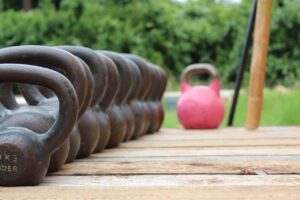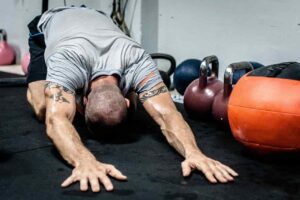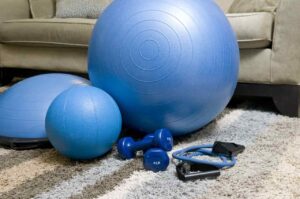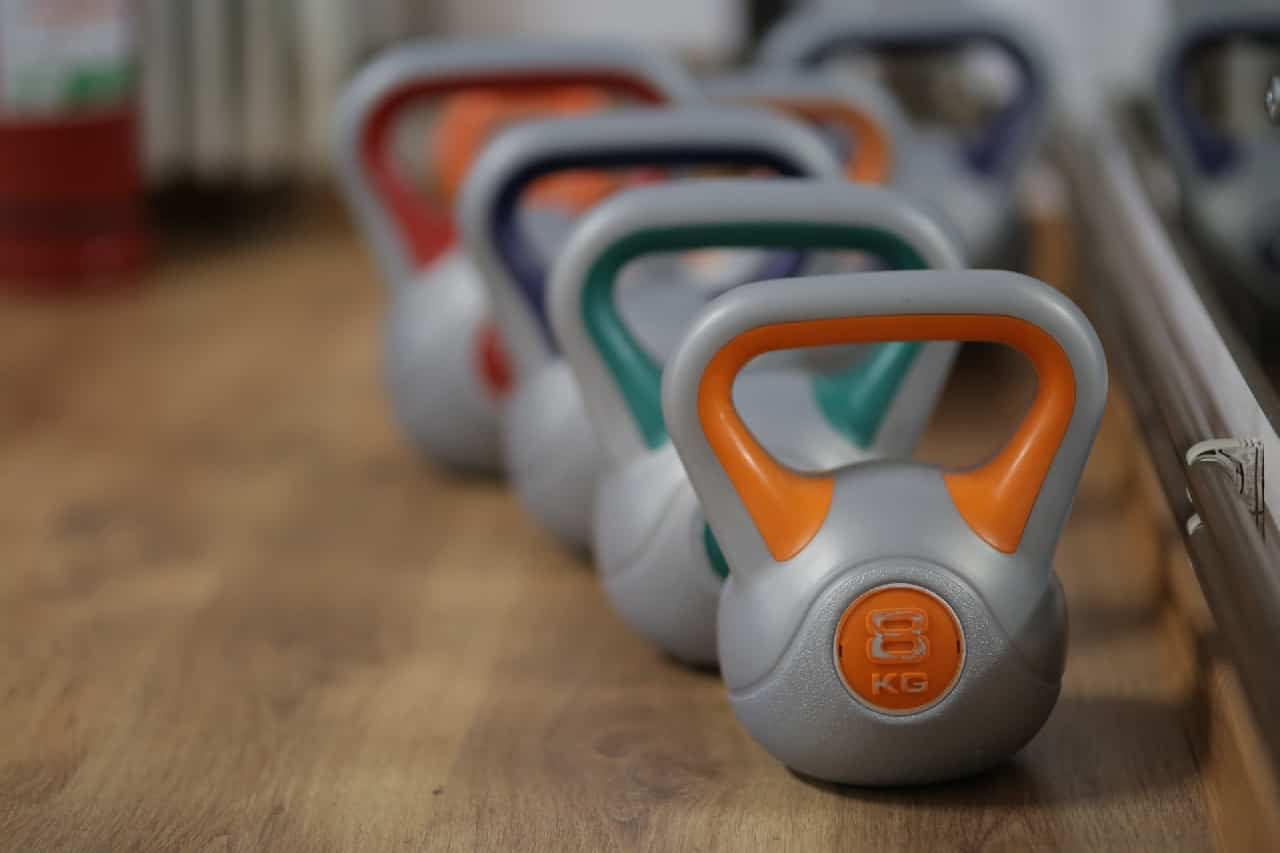The pandemic has pushed billions back into their homes, forcing us to work remotely. You’re here because you’re concerned with your health or just want to get back in shape. Don’t worry; it’s entirely possible to work for 8+ hours on your computer every day and have 6-pack abs.
Here are 12 tips on how to get fit while working from home:
- Stay hydrated.
- Eat a balanced diet.
- Create a full-body workout plan and stick to it.
- Do high-intensity interval training twice a week.
- Do cardiovascular exercise for 150 minutes per week.
- Practice yoga twice a week.
- Work at a standing desk.
- Get a pull-up bar.
Getting fit takes a lot of time and effort, but it’s achievable if you stay consistent. In this article, I’ll share a few key ways to get super fit without ever having to leave your home.

1. Stay Hydrated
I know it sounds super cliche, but staying hydrated is the first (and easiest) step to getting more fit.
Of course, you lose a lot of water when you exercise in the form of sweat. So, you have to replace all the lost liquid during and after exercising. But there’s a lot more to it.
So, why is proper hydration so important for fitness?
It’s because proper hydration is essential for electrolyte balance and proper neuromuscular coordination.
To understand why optimal nerve function is important, you must understand how muscles contract.
Your brain sends an electric impulse through the central nervous system. The nerve endings tell the muscle fibers to contract.
Keeping your nervous system hydrated results in stronger contractions. Therefore, hydration directly leads to better strength which directly translates into you gaining more muscle mass. Hydration is the most basic tip to get fit while working from home.
An additional benefit of staying hydrated is that you’ll feel less fatigued in general. You’ll also have healthier skin and joints.
If your goal is to lose fat, water is your friend.
A study on drinking water before a meal has discovered that drinking water before and during a meal reduces energy intake.
Additionally, drinking a glass of ice-cold water on an empty stomach burns about 8 calories.
It doesn’t sound like much. But if you drink two glasses of cold water each morning, that’s about 100 calories a week just by drinking water.
2. Eat a Balanced Diet
A healthy diet with enough micronutrients and a caloric deficit will do all the heavy lifting in your weight loss plan.
There’s a popular saying in fitness: “You can’t outrun a bad diet.”
The most important thing about eating healthy is that you know what the food you’re eating contains. Check the nutrition facts for everything you ingest.
Let’s go over a few important aspects of a healthy, balanced diet.
Eat Enough Protein
If your idea of getting fit is building a lot of muscle, you’ll have to maximize your protein intake.
The most accurate way to determine how much protein you need is to go by lean body mass weight. You should consume 2.2 g of protein per kg.
For example, a person who weighs 80 kg (176 pounds) and has a body fat percentage of around 15% has 68 kg (150 pounds) of lean body mass. The person should consume about 150 g (5.3 oz) of protein.
If it’s hard for you to measure or make an estimate on your body fat percentage, consume between 1.2 g – 1.7 g of protein per kg.
Another benefit of eating a lot of protein is that they make you feel fuller for longer than fats and carbs.
The maximum calories you get from protein should be limited to 35%. If you regularly eat more than that, you’re increasing the risk of liver and bone damage as well as kidney stone formation.
Avoid Trans Fats
Trans-fatty acids are very bad for you. In addition to being high in calories, trans fats increase bad cholesterol in your body. This puts you at risk of heart disease.

It’s impossible to avoid trans fats altogether. Nonetheless, try to eat less of these foods:
- Hydrogenated fats
- Butter, shortening, and margarine
- High-fat cuts of red meat
- Deep-fried foods
- Chicken wings, thighs, and drumsticks
- Full-fat cheeses
Give Up Simple Carbohydrates
If there’s a single “shortcut” to getting fit, it’s restricting how many carbs you eat. And I’m not talking about complex, starchy carbohydrates found in potatoes, whole grains, and oats.
Most calories should come from carbs, so it’s not healthy to follow a keto diet.
Instead, replace your white rice and white bread with whole-grain varieties.
Most importantly, avoid desserts at all costs. Chocolate, cake, and sodas are the worst offenders.
Quit Ordering Takeout
Food delivery services have seen an enormous spike in demand since the start of the pandemic.
It’s all right to order takeout once or twice a week, but it shouldn’t be a daily habit.
It’s always healthier to cook your own food. You control what ingredients go into the dish, and it’s easier to manage portion sizes too.
Eat a Minimum of Five Servings of Fruits and Vegetables
You’ve probably heard at one point that 5 daily servings of fruits and vegetables are the key to a healthier lifestyle.
It’s because micronutrients and antioxidants found in fruits and veggies reduce cancer risk and boost your cardiovascular health.
For most fruits and veggies, one serving is about one cup. Ideally, you should eat 5 different fruits and vegetables throughout the day. Cutting out take out is a great way to get fit while working from home.
3. Create a Full-Body Workout Plan and Stick To It
Since hitting your local gym may not be a possibility due to the pandemic, we’ll stick to working out at home.
You can certainly get super fit in the comfort of your home.
The most important thing is that you’re determined and consistent. It’s okay to skip a day because you don’t feel like exercising. But make sure to catch up the very next day.
You can follow a pre-made workout plan or use an app to get started.
However, such programs may kill your motivation to work out in the first place.

I find that even the most beginner-friendly workout plans are extremely demanding. They’ll have you doing 10 push-ups by week three, which is way too much.
Instead, start out slowly and increase the difficulty as you get stronger.
Fitness experts recommend that you do full-body workouts 1-3 times a week. You can build a ton of strength using nothing but your own body weight.
Let’s now go over a few of my favorite beginner-friendly exercises that you can do at home.
Knee Push-Ups
Knee push-ups are a super easy alternative to traditional push-ups. It’s the perfect gateway to unlocking more challenging variations of push-ups.
Here’s how you do knee push-ups:
- Place your hands shoulder-width apart.
- Rest the weight of your lower body on your knees.
- Go down until your chest is a few inches away from the floor.
- Keep your core muscles (abs, lower back, glutes) engaged throughout the whole exercise.
- Push up using your pecs (chest muscles), shoulders, and triceps until your arms are locked out.
Start with two sets of 5 reps per workout and progress to four sets of 10 before moving to traditional push-ups. If you plan to have your computer active while working out, be sure you know how to mute on zoom so coworkers can’t hear sound.
Squats
Working from home entails a lot of sitting. This leads to muscle atrophy in your muscles (especially glutes and hamstrings), as well as back and joint pain.
Squats are the #1 exercise for strong, toned legs and butt. They’re also great for your core muscles.
Moreover, they strengthen and increase mobility in your knees, ankles, and hips.
Here’s how to do squats correctly:
- Place your feet shoulder-width apart.
- Keep your head and torso up and your lower back straight.
- With your core engaged, slowly lower as if you wanted to sit down.
- Go as deep as you can. It’s best if your legs can get below knee height. Don’t worry if they don’t because you’ll get better.
- Lift yourself back up. Make sure you’re not locking out your knees.
Do two sets of 8 and progress until you can do 4 sets of 12. Add weight after that.
Crunch, Reverse Crunch, and Russian Twist
There are hundreds of different ab exercises. But crunches, reverse crunches, and Russian twists are more than enough to get fit if you do them regularly.
The combination will target your lower and upper abs and the obliques.
Do them in the following order:
- Reverse crunch
- Russian twist
- Crunch
Here’s how to do the reverse crunch:
- Lay on your back.
- Slightly bend your knees.
- Lower your legs until they’re nearly touching the floor.
- Raise your legs until your knees are nearly touching your chest. Your butt and lower back will lift from the floor.
Watch this video by Howcast to learn how to do Russian twists:
Lastly, here’s how to do an old-fashioned crunch:
- Lay on your back.
- Place your feet hip-width apart on the floor with your knees bent.
- Lift your upper body until you feel a strong contraction in your upper abs. Keep your lower back and glutes planted to the floor through the whole movement.
Numbers don’t mean that much when it comes to abs.
Focus on the contractions and try to squeeze in as many reps as you possibly can.
Do 1 to 3 sets of each exercise. Do them one after another without rest.
Kettlebell Swings
Kettlebell swings are a fantastic full-body exercise. The best part of kettlebell swings at home is that you don’t even need a kettlebell!
Here are a few alternatives to a kettlebell:
- Large bottle or milk jug
- Backpack
- Jerry can
- Detergent jug
Water jugs are my favorite. Some of them have a handle that’s identical to a regular kettlebell.
Here is how you do a kettlebell swing with the item of your choice:
- Place your feet shoulder-width or more apart.
- Take the weight using both hands. It should sit between your legs.
- Keep your back straight and your chin up.
- Drive the weight up by thrusting your hips forwards and swinging the kettlebell.
- Stop when the weight is in front of your chest.
Kettlebell swings are great for explosive strength. Plus, they’re very easy to do. Do two sets of 10 and progress to five sets of 15.
4. Do High-Intensity Interval Training Twice a Week
HIIT is short for high-intensity interval training. It’s a form of exercise that utilizes short, explosive bursts of anaerobic exercise combined with a slow recovery interval.
HIIT combined with standard resistance training (the type that builds muscle, like push-ups) is the most effective way to turn yourself into a real athlete.
HIIT has numerous advantages over traditional cardio, such as:
- HIIT expends 40-60% more calories per minute.
- Your body continues burning extra calories long after training.
- HIIT increases your VO2 (maximal oxygen uptake).
- HIIT takes less time to complete.
- HIIT helps you lose visceral fat.
- HIIT builds muscle.
So, you get most of the benefits of cardio and tone your legs along the way too. That’s because of the significantly higher recruitment of fast-twitch muscle fibers compared to cardio.
But how do you actually do HIIT?
You can transform almost any exercise into HIIT. After a proper warm-up, alternate between 15-30 seconds of intense exercise and 15-60 seconds of recovery.
You still do the exercise during the recovery period, but it’s much slower.
Here’s how I do HIIT running:
- Walk for 2 minutes.
- Jog for 3 minutes.
- Sprint quickly for 30 seconds.
- Jog or walk for 60 seconds.
- Repeat until exhaustion.
- Walk for 5 minutes or until your heart rate is back to normal to cool down.
You’ll get much better at HIIT as you progress. If it becomes too easy, reduce the recovery period and work out more intensely.
Here are a few other popular exercises that you can use for HIIT:
- Jumping jacks
- Lunges
- Squats
- Push-ups
- Cycling
- Jump rope
5. Do Cardiovascular Exercise for 150 Minutes per Week
Cardiovascular training is excellent at building endurance. Additionally, it makes your heart pump blood more efficiently and your blood vessels healthier.
I could go on forever about the various benefits of cardio. But we’re here to get fit.
CDC explains that 150 minutes of cardio weekly will maintain your weight.
If you want to lose weight, I suggest that you stick to the 150-minute mark nonetheless.
Instead, combine traditional low-intensity cardio with HIIT and full-body training. The mix of these three produces the best results.
So, how do you go about doing cardio at home without any equipment?
Running in place is one way.
If you have enough space in your home, jump rope is a great way to end your workday.
Burpees, jumping jacks, and kettlebell swings are all forms of cardio that you can do at home as well.
6. Practice Yoga Twice a Week
Yoga is the best way to improve fitness while working from home. If you are struggling to find time, use an appointment scheduler for freelancers and book work from home exercise breaks. This will help you practice yoga while still earning.
You’re probably in pain from sitting at your desk all day long. Sitting leads to a loss of mobility too.

Practicing yoga a few times a week helps restore your mobility.
The best thing is that you can do it at home by following online yoga lessons on YouTube.
Yoga has many of the same benefits as resistance training:
- Improved strength and fitness levels.
- Improved posture.
- Burns calories.
- Builds muscle mass.
- Strengthens your core.
7. Work at a Standing Desk
If you’re working from home full-time, buying a standing desk is a no-brainer. Additionally, there are many tax deductions for independent contractors including standing desks if its used 100% for business purposes.
Standing burns 0.15 calories per minute. That’s about 9 calories for each hour that you stand.
The numbers rack up day-to-day, though. If you work 5 days a week and spend 5 of your 8 hours standing instead of sitting, that’s a whopping 225 extra calories burned each week.
But that’s far from the only benefit of working at a standing desk.
You’ll also be slightly more productive and attentive, build endurance, tone your legs, and suffer less back pain.
Another potential benefit is that you’ll be more likely to take short breaks to walk around the house. Avoid the kitchen because you might grab a quick snack from the fridge, though!
8. Get a Pull-up Bar
Pull-ups are one of the best exercises to get super fit and strong. They recruit all back and core muscles and your biceps.
If you want a massive back, pull-ups and chin-ups are everything you’ll need.
A pull-up bar is the single best piece of equipment you can get to get fit while working from home. You can mount a pull-up bar in your doorway, on the ceiling, or on the wall.
The beauty of pull-ups is that they’ll exhaust you in less than a minute. So, you can easily squeeze a couple of pull-ups into your work breaks.
Don’t be discouraged from getting a pull-up bar because you can’t do pull-ups in the first place.
I couldn’t do a single pull-up even after three months in the gym. But that’s until I started doing negative pull-ups.
To do a negative pull-up, jump and squeeze the pull-up bar as hard as you possibly can. Make a slow, controlled descent. Repeat this as often as you can.
You can get the ProsourceFit Doorway Pull-Up Bar from Amazon.com. It’s easy to install and has soft foam handles that make exercising easier.
Work-At-Home Fitness Summary
Getting fit while working from home is possible. There’s no quick and easy way, though. You must put in the effort to see results. You can also stay fit even when you work remotely and travel by following these tips.
Try everything mentioned in this article to see what sticks. You’ll get more fit faster if you combine several forms of exercise, such as HIIT and full-body resistance training.





Leave a Reply